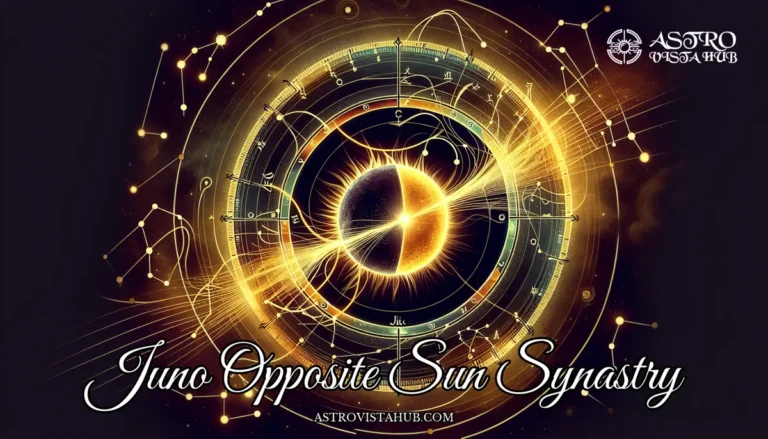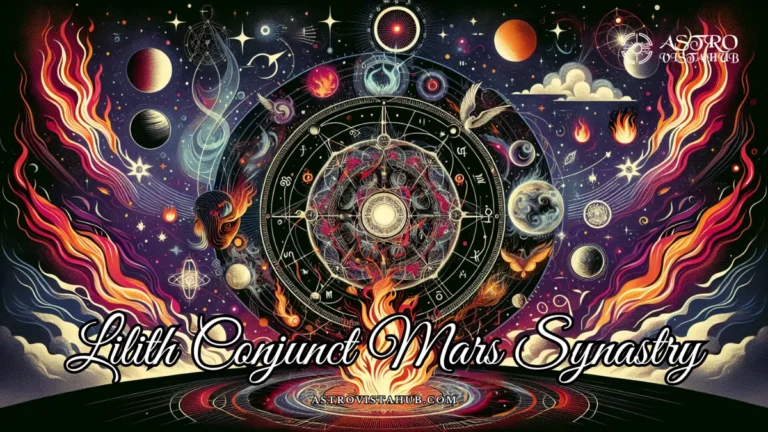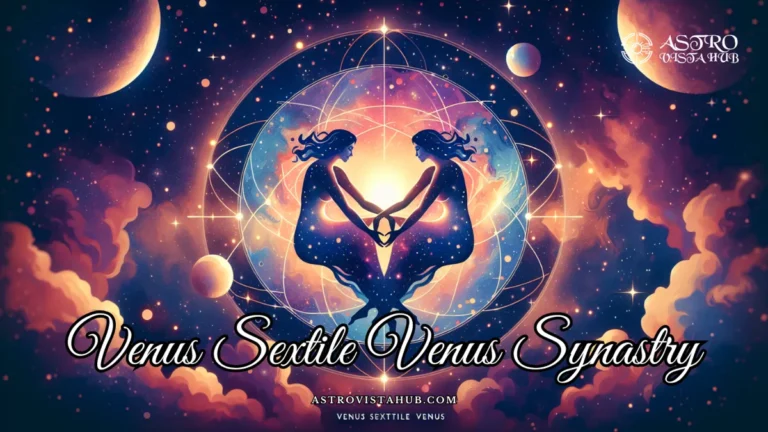
Juno Opposite Ascendant Synastry: Exploring the Dynamic Interplay of Commitment and Individuality
In the celestial tapestry of astrological synastry, the aspect of Juno opposite Ascendant weaves a captivating tale of attraction, commitment, and the delicate dance between individuality and partnership. This celestial interplay between the asteroid Juno, representing the essence of committed relationships, and the Ascendant, symbolizing one’s individual expression and persona, creates a dynamic tension that invites exploration and growth.
The Essence of Juno Opposite Ascendant
At the heart of this aspect lies a profound and magnetic attraction, drawing two individuals together in a way that transcends the superficial. It is a connection that delves into the depths of what it means to be truly seen and understood by another, to have one’s deepest desires and needs reflected in the mirror of a partner’s soul.
Juno opposite Ascendant is seen as the ‘ideal relationship’ in astrology and is commonly found in successful marriages.
The Juno person embodies the qualities that the Ascendant person perceives as their ideal partner, a living embodiment of the traits they have longed for in a committed relationship. This aspect carries with it the promise of a deep and passionate connection, an intense attraction that can feel akin to love at first sight. The Ascendant person may find themselves drawn to the Juno person in a way that feels almost destined, as if they have found the missing piece to their puzzle.
However, this aspect is not without its challenges. While the Juno person may represent the qualities that the Ascendant person desires in a partner, there is an inherent tension between the need for commitment and the expression of individual freedom. The Ascendant person may feel a pull towards the security and stability that the Juno person represents, while simultaneously grappling with the desire to maintain their sense of autonomy and independence.
The Dance of Commitment and Individuality
The aspect of Juno opposite Ascendant sets the stage for a delicate and intricate dance, one that requires both partners to navigate the intricate balance between commitment and individuality. It is a journey that demands openness, compromise, and a willingness to embrace the inherent tensions that arise.
For the Juno person, the challenge lies in understanding and respecting the Ascendant person’s need for personal freedom and self-expression. It is essential to create a space within the relationship where both individuals can explore their unique identities without feeling stifled or suffocated. This may involve redefining traditional notions of commitment and partnership, allowing for the expression of individual desires and aspirations within the context of a shared bond.
“This aspect brings balance and complementarity to the relationship, as the Juno person provides the qualities that the Ascendant person feels they lack.”
On the other hand, the Ascendant person must learn to navigate the delicate balance between honoring their individuality and nurturing the deep connection they share with the Juno person. This may involve finding ways to integrate their personal aspirations and goals with the shared vision of the relationship, fostering a sense of unity without sacrificing their authentic selves.
By embracing the challenges presented by this aspect, both individuals have the opportunity to grow and evolve in profound ways. The Juno person may learn to cultivate a deeper understanding and appreciation for the Ascendant person’s need for independence, recognizing that true commitment does not necessitate the sacrifice of one’s identity. Conversely, the Ascendant person may discover the true beauty and fulfillment that comes from committing to a partnership built on mutual respect and understanding, where both individuals can thrive and flourish together.
The Transformative Power of Juno Opposite Ascendant
One of the most remarkable aspects of Juno opposite Ascendant is its ability to catalyze personal growth and transformation on a profound level. This aspect invites both individuals to explore the depths of their desires, fears, and vulnerabilities, creating a fertile ground for self-discovery and self-awareness.
As the relationship unfolds, both partners may find themselves confronted with their own insecurities and limiting beliefs, deeply rooted patterns that have shaped their perspectives on love, commitment, and self-expression. The Juno person may grapple with fears of abandonment or feelings of inadequacy, stemming from past experiences or societal conditioning. Meanwhile, the Ascendant person may wrestle with the desire for complete freedom and the fear of losing themselves in the relationship, a fear that can often be traced back to a sense of disconnection from their authentic selves.
However, by confronting these challenges head-on and embracing the transformative power of this aspect, both individuals have the opportunity to shed the layers of fear and limitation that have held them back. They can emerge as more authentic, empowered versions of themselves, better equipped to navigate the complexities of life and love with a newfound sense of self-awareness and resilience.
“Embrace the potential for growth and personal evolution that arises from this dynamic aspect.”
Through this process of self-exploration and transformation, the individuals in a Juno opposite Ascendant synastry may uncover profound truths about themselves and their relationship. They may discover that true commitment is not a prison, but rather a sanctuary where both individuals can fully express their authentic selves while being supported and nurtured by a partner who understands and celebrates their unique essence.
Nurturing the Connection: Practices for Harmony
While the challenges of Juno opposite Ascendant should not be underestimated, it is important to remember that this aspect also holds immense potential for fostering a deep and lasting connection. By cultivating a foundation of mutual respect, open communication, and a willingness to compromise, both individuals can create a relationship that honors their individual needs while nurturing the bond that binds them together.
Here are some key practices that can help nurture the connection and foster a harmonious dance between commitment and individuality:
- Communicate openly and honestly: Encourage open dialogue about each other’s needs, desires, and boundaries. This fosters understanding and helps to prevent misunderstandings, allowing both individuals to feel heard and valued.
- Embrace quality time: Make time to connect on a deeper level, whether through shared experiences, intimate conversations, or simply being present with one another. These moments of connection can help to strengthen the bond and remind both partners of the beauty and richness of their relationship.
- Support each other’s growth: Encourage and support one another’s personal goals and aspirations, creating a space where both individuals can thrive and evolve without fear of judgement or limitation. Celebrate each other’s successes and provide a listening ear and a shoulder to lean on during times of struggle.
- Practice compromise: Be willing to meet each other halfway, finding creative solutions that honor both individual needs and the needs of the relationship. This may involve negotiation, flexibility, and a willingness to step outside of one’s comfort zone for the greater good of the partnership.
- Celebrate individuality: Embrace and celebrate each other’s unique qualities and perspectives, recognizing that it is often our differences that make the connection so rich and rewarding. Foster an environment where both individuals can express their authentic selves without fear of rejection or criticism.
- Nurture intimacy: Cultivate intimacy in all its forms, whether physical, emotional, or spiritual. This can help to deepen the connection and create a safe space where both individuals can be vulnerable and fully present with one another.
By fostering a deep sense of mutual respect, trust, and understanding, the individuals in a Juno opposite Ascendant synastry can create a relationship that is truly transformative and deeply fulfilling. They can navigate the challenges and embrace the opportunities for growth, emerging as more whole and integrated beings, better equipped to face the complexities of life and love together.
The Beauty of Polarity and Harmony
At the heart of the Juno opposite Ascendant aspect lies a powerful reminder of the beauty and richness that can arise from the interplay of opposites. While this aspect may present challenges in terms of balancing commitment and individuality, it also offers a profound opportunity for growth and the cultivation of a harmonious, complementary partnership.
Like the yin and yang, the Juno person and the Ascendant person represent two halves of a whole, each bringing their unique qualities and perspectives to the relationship. The Juno person may embody the qualities of stability, commitment, and nurturing, while the Ascendant person may represent the energy of self-expression, independence, and personal growth.
When these two polarities are embraced and celebrated, rather than resisted or suppressed, they can create a dynamic synergy that allows both individuals to thrive and flourish together. The Juno person can provide a solid foundation of support and security, creating a safe haven for the Ascendant person to explore and express their authentic self. Conversely, the Ascendant person can inspire the Juno person to step outside of their comfort zone, encouraging them to embrace new experiences and perspectives that foster personal growth and evolution.
“In the dance of polarities, we discover the harmony of wholeness.”
By learning to navigate the tensions and embrace the polarities inherent in the Juno opposite Ascendant aspect, both individuals have the opportunity to create a relationship that is truly balanced and harmonious. They can cultivate a partnership that honors and celebrates their individual identities while simultaneously fostering a deep and lasting connection rooted in mutual respect, trust, and unconditional support.
Conclusion
The aspect of Juno opposite Ascendant in synastry is a powerful and dynamic force, one that invites us to explore the depths of our desires for connection and individuality. It is a dance that requires both partners to navigate the delicate balance between commitment and personal freedom, embracing the inherent tensions and challenges that arise along the way.
Yet, within this dance lies the potential for profound growth, transformation, and the cultivation of a deeply fulfilling and lasting connection. By embracing the lessons and opportunities presented by this aspect, both individuals have the chance to emerge as more authentic, empowered versions of themselves, better equipped to navigate the complexities of life and love.
As we journey through the intricacies of this aspect, we are reminded of the beauty and richness that can arise from the interplay of opposites. Like the yin and yang, the Juno person and the Ascendant person represent two halves of a whole, each bringing their unique qualities and perspectives to the relationship. When these polarities are embraced and celebrated, they can create a dynamic synergy that allows both individuals to thrive and flourish together, cultivating a partnership that is truly balanced and harmonious.
So, let us embrace the journey of Juno opposite Ascendant with open hearts and minds, recognizing that it is through the exploration of our deepest desires and the navigation of our inherent tensions that we can truly discover the beauty and richness that lies at the heart of every profound connection. Together, we can dance the dance of commitment and individuality, weaving a tapestry of love, growth, and transformative union that transcends the boundaries of self and other.







